Waves' excellent Abbey Road bundle delivers the sounds of the vintage gear from that esteemed studio's golden age (' 60s–' 70s), and their newest addition to that collection is the TG12345 plug-in, a modeled version of the classic EMI TG solid -state console, in use from the late '60s through the '70s-early '80s, starting with the Beatles' Abbey Road album, on through many classic recordings of the '70s, like Pink Floyd's Dark Side Of The Moon and Wish You Were Here. The solid-state TG12345 replaced the tube-based REDD consoles, also modeled in the Abbey Road bundle (REDD.17 and REDD.37/.51). providing a cleaner, punchier sound than the REDDs. The studio's TG was first used on the Beatles' Abbey Road album, lending its crisper sonics to that classic recording, and various versions of the TG12345 (MkI-IV) were mainstays at Abbey Road for the next decade.
Fig 1 An original TG12345 console.
Just as with the other Abbey Road plug-ins, Waves' TG12345 is true to the sound and feature set of the original, but it does combine the slightly different features of the different TG versions, and it adds an extra option or two to insure that the plug-in will serve well in any situation.
TG 12345 Features
Fig 2 The Waves TG12345 plug-in.
The plug-in comes in mono and stereo versions—the stereo version has a couple of extra features, including the original TG's handy “Spread” control (more on that below). The original console was a modular design—EMI called the modules “cassettes”—with Microphone, Group, and Main (Output) modules. Across the top of the plug-in window are input level controls (left), metering (right), and a routing switch (center). Below, there are three panels—running left-to-right, Dynamics, EQ, and the Fader section, which includes some plug-in additions. The Routing switch determines the position of the Dynamics and EQ sections.
In the TG MkI version, the (Mic) channel had Dynamics and simple Bass & Treble EQ, with another Dynamics section and a more flexible semi-parametric “Presence” EQ on the Groups and Outputs. The MkII and later versions substituted the Presence EQ for the treble band on the Mic channels. The plug-in's Routing switch lets you choose the order of these three components—Dynamics, (Bass & Treble) EQ, and Presence. The three options are EQ>DYN>PRES, DYN>EQ>PRES, and EQ>PRES>DYN.
Setting the Tone

Fig 3 The TG12345 EQ & Presence section.
The Bass & Treble EQ controls are similar to the REDD.37/51 EQ—shelving treble (10 dB cut @ 10 kHz) and bass (±10 dB @ 100 Hz), with a peaking treble boost (10dB @ 5 kHz)—but modeled on the solid-state electronics of the TGs, as opposed to the tube circuitry of the REDDs. This gives these EQs a cleaner, more open sound, but they still have a nice smooth character. The Presence controls offers ±10 dB at a range of frequencies from 500 Hz up to 10 kHz. The original Presence section's options were no doubt derived from the EMI RS56 tube EQ (also modeled in the Abbey Road bundle), but, in the TG console/plug-in, implemented with transistorized circuitry. The original EQ and Presence were stepped controls, but Waves has combined this behavior with a more modern continuous range—clicking on the frequency labels, for example, chooses from just those frequencies, as on the original, while turning the controls with the mouse allows for continuous selection.
Audio Example 1 Instruments w/o, then with TG12345 EQ:
Dynamics
I found the Dynamics section—the TG12345's compressor/limiter—to be one of the standout features of the plug-in. The earlier REDD consoles didn't have built-in dynamics, so Abbey Road's engineers utilized outboard compressors—notably the legendary tube-based Fairchild models (660/670) and Altecs. The TG's solid-state Dynamics section, while employing a different design, was conceived with those favored compressors in mind.
The TG Dynamics section offers a Compression mode (~2:1 Ratio) and a Limiter mode (~ 7:1 Ratio), both with a fixed Attack Time of 1 millisecond. It's a VCA design, utilizing a DC Feedback loop in an internal sidechain to control gain reduction.
Fig 4 The internal design of the TG12345 Dynamics section.
This is a fairly standard approach, but there are some less-traditional aspects here as well. The TG compressor also provides some upward gain for low-level signals, and the controls are a bit different from more traditional compressor options. Instead of a control labeled Threshold, there's a “Hold” knob. This sets a fixed DC voltage in the sidechain, and when the input signal level exceeds this level in the sidechain, gain reduction follows the signal; when the input is below this threshold, there's a fixed amount of gain reduction. This can provide for a smooth characteristic, but it can also be set for fairly aggressive compression as well. In use, with the Hold control at minimum, the entire signal range is subject to gain reduction—raising the control adjusts the range of compression, for a more subtle effect.
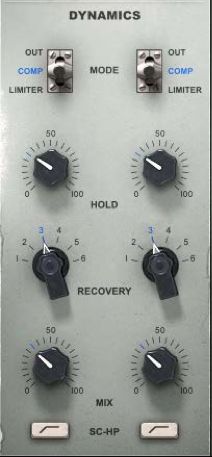
Fig 5 The TG12345 Dynamics section.
The Recovery knob sets the release time, with six options (similar in layout to the Fairchild's Release control)—100 ms, 250 ms, 500 ms, 1 sec, 2 sec, and 4 sec. The remaining two controls on the Dynamics section are Waves' add-ons (not on the original console). A high-pass filter in the sidechain-only cuts below 90 Hz, to reduce potential undesirable pumping triggered by low-frequency signals (like kick drum or bass) without affecting the tone of the signal itself. The Mix knob allows for more convenient parallel compression, with 0% being dry-only and 100% compressed-signal-only. This is another way, in addition to the Hold control, to dial up just the degree of compression you want, letting you set a fairly strong compression characteristic and then blending it with the original for a more subtle overall effect. Any makeup gain needed would be set with the main channel fader, at the right.
Audio Example 2 Bass & Drums, each w/o, then w TG Compressor/Limiter:
Wide Load
To the right is the Fader section. In the mono version of the plug-in, this is a fairly simple affair. In addition to the main fader, there's a Channel Select control, to choose from the two slightly different-sounding console channels Waves modeled for the plug-in (this very subtle feature is also implemented in other plug-ins in the Abbey Road bundle, like the REDD consoles and J37 tape machine). Noise and Drive offer the option of adding the level of noise and grit that you might have encountered with the original circuitry—Drive, in particular, is probably more useful in the REDD plug-ins, where it can push the tube overload you'd have gotten from those amplifiers, but it's nice to have it here as well.
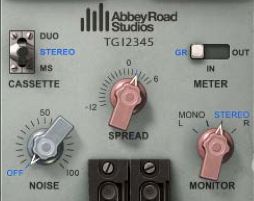
Fig 6 The TG12345 Spread control.
The stereo version adds controls to select linked stereo processing, independent Left & Right channel settings, and MS processing, and the options to monitor the signal in normal Stereo, Mono, Left or Right only, or, in the MS mode, Mid or Side signals only. MS processing allows for independent processing of the center (summed mono) signal and the difference signal—the sides. The Side signal is usually ambience and things panned to the left and right (like cymbals or background vocals in a mix), and being able to EQ and compress center-panned components like kick, snare, bass, and lead vocal, independently from other components of a track or mix, is a very useful tool. This option is also included with the REDD console plug-ins, but here there's an additional control here, from the original TG consoles, labeled Spread. This adjusts the balance between the Mid and Side signals (it adds or subtracts the Side level against the fixed Mid level)—increasing Side level can widen the left-right spread, decreasing will narrow it. The Spread knob works even when you're not in MS mode, making it especially convenient for Drum kits, pianos, full mixes, and other signals where some width adjustments may be desired.
Audio Example 3 A mix (incl. TG EQ & Comp) through the TG12345 Spread control: first normal Stereo; then narrowed (to the minimum Spread setting); then widened (to the maximum Spread setting, emphasizing the wide-panned guitars); then back to normal Stereo:
Wrap-up
Just as with all the other Abbey Road plug-ins, the TG12345 has been carefully modeled to capture all the character of the original console. It's EQ is tasty, and the Compressor/Limiter has a unique quality that, once you get used to its operation, can really add some wonderful oomph to drums, bass, vocals—almost anything seems to benefit from the right settings. The Spread control is one of those features that gets more use that you might expect. Overall, the TG12345 is a worthy addition to the Abbey Road collection, and certainly a must-have for fans of the classic recordings made with the original gear!
Price: Regular Price: $200; Current Sale Price: $99; Discount available for Abbey Road Collection owners. Pros: Great-sounding model of classic console; excellent EQ & compressor; useful Spread control. Cons: Compressor controls a little different than the usual (though true to the original). Web: http://www.waves.com/plugins/emi-tg12345#tg12345-overview |
Learn more about the Waves Abbey Road bundle at AskVideo here.


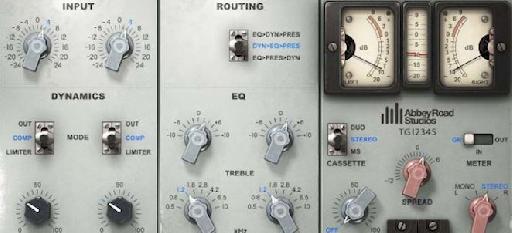
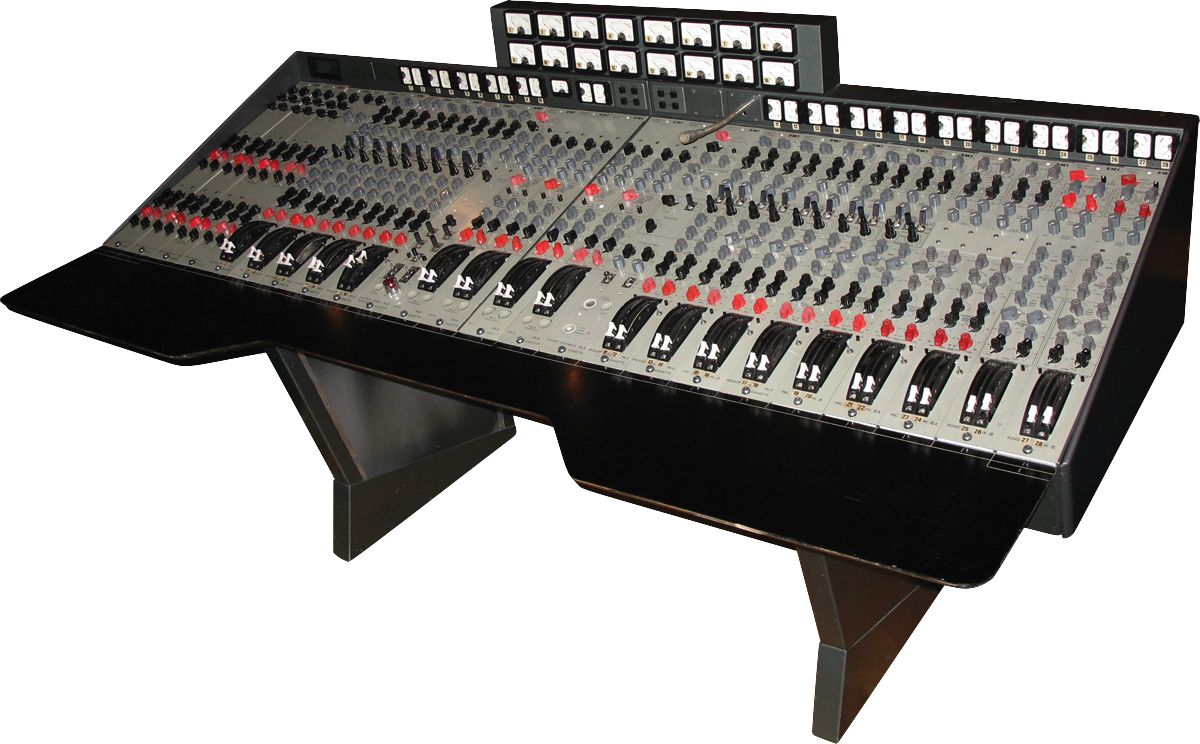

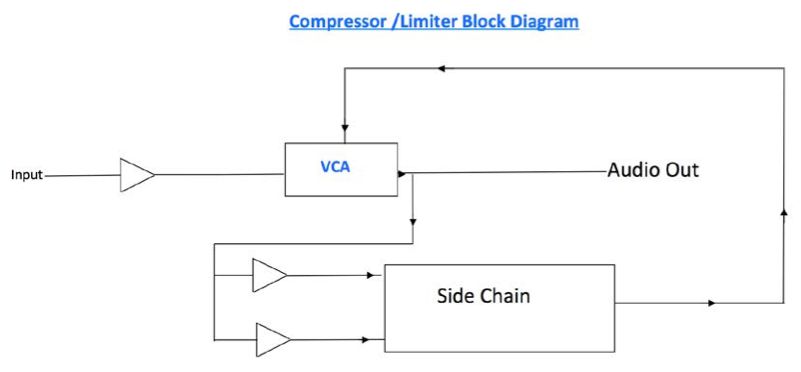
 © 2024 Ask.Audio
A NonLinear Educating Company
© 2024 Ask.Audio
A NonLinear Educating Company
Discussion
Want to join the discussion?
Create an account or login to get started!